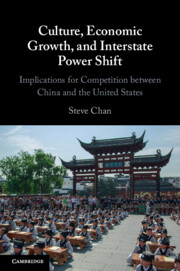 Culture, Economic Growth, and Interstate Power Shift
Culture, Economic Growth, and Interstate Power Shift Book contents
- Culture, Economic Growth, and Interstate Power Shift
- Reviews
- Culture, Economic Growth, and Interstate Power Shift
- Copyright page
- Contents
- Acknowledgments
- 1 Introduction
- 2 The Origins of Culture and Its Effects on Economic Development and Political Order
- 3 The Struggle between Materialist and Postmaterialist and China’s Economic Growth in Historical and Comparative Context
- 4 Economic Growth, Interstate Primacy, and Domestic Trade-offs
- 5 Innovation, Leading Sectors, and International Competitiveness
- 6 Conclusion
- References
- Index
2 - The Origins of Culture and Its Effects on Economic Development and Political Order
Published online by Cambridge University Press: 01 February 2024
- Culture, Economic Growth, and Interstate Power Shift
- Reviews
- Culture, Economic Growth, and Interstate Power Shift
- Copyright page
- Contents
- Acknowledgments
- 1 Introduction
- 2 The Origins of Culture and Its Effects on Economic Development and Political Order
- 3 The Struggle between Materialist and Postmaterialist and China’s Economic Growth in Historical and Comparative Context
- 4 Economic Growth, Interstate Primacy, and Domestic Trade-offs
- 5 Innovation, Leading Sectors, and International Competitiveness
- 6 Conclusion
- References
- Index
Summary
Why some groups outperform others in academic and professional achievements? Why some countries’ economies grow faster than others? Why are the fastest-growing economies located in East Asia? What role does Confucian heritage play in helping countries in this region to outperform others economically? How do culture, institutions, and policy interact to influence each other?
Keywords
- Type
- Chapter
- Information
- Culture, Economic Growth, and Interstate Power ShiftImplications for Competition between China and the United States, pp. 17 - 58Publisher: Cambridge University PressPrint publication year: 2024


